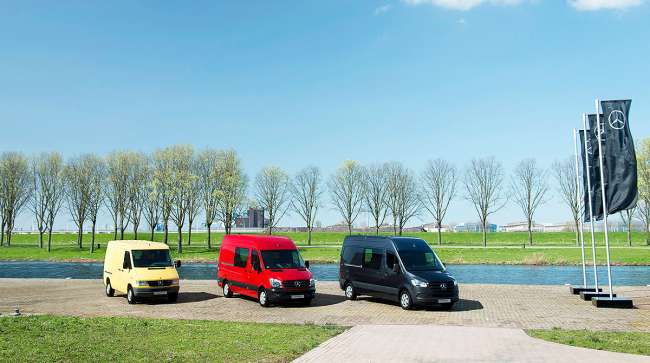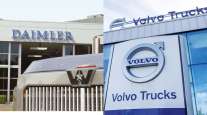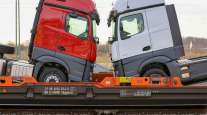Senior Reporter
Daimler Marks Milestone as Sprinter Turns 25

[Stay on top of transportation news: Get TTNews in your inbox.]
Daimler AG celebrated a 25-year milestone for its Mercedes-Benz Sprinter model, which began production in 1995, and whose roots go back 40 years to the company’s initial array of small cargo vehicles in various shapes.
The U.S. has become the second-largest market for Sprinter vans, after Germany, the Stuttgart, Germany-based company said.
Sprinter has “defined an entire vehicle segment and also was the founding of our van division,” Norbert Kunz, who has been head of marketing at Sprinter for 20 years, said during a webinar June 5.
Before the Sprinter, there was the L 319. The L 309 was next and nicknamed the Düsseldorfer because it was produced in Düsseldorf, where the Sprinter is produced. The T1 came along in 1977, and for the first time included standard front disc brakes, and, later, options like air conditioning and anti-lock braking became available.
In related news, nearly three months after the first effects of the COVID-19 pandemic suspended manufacturing operations, Daimler Trucks North America has reopened all nine of its manufacturing locations in North America — most recently with the Saltillo and Santiago truck manufacturing plants in Mexico on June 1.
Mercedes-Benz Vans has a plant in Ladson, S.C., that assembles Sprinter vans for the U.S. and Canadian market under the brands Mercedes-Benz and Freightliner. More than 185,000 Sprinter and Metris vans have been assembled there and delivered to destinations across the U.S. since 2006.
Daimler has sold more than 4 million Sprinters in more than 130 countries. “We put all our expertise into this vehicle and all our know-how,” Kunz said.
Meet Mercedes DIGITAL: The Mercedes-Benz Sprinter – 25th anniversary https://t.co/kgFm9MuBQi — Mercedes-Benz (@MercedesBenz) June 5, 2020
The first-generation Sprinter, he said, shared features with Mercedes-Benz passenger cars — including four disc brakes, ABS, air bags, a common rail diesel engine plus good acceleration and low fuel consumption, “so it was very comfortable to drive for our customers.”
The second generation, out in 2006, had an electronic stability program that now is load-adaptive, recognizing size and position of the payload. Other safety and assistance systems that came to the vans segment directly from its cars were adaptive crosswind collision prevention, active brake assist and blind spot assist, for example.
The latest Sprinter has a new infotainment system, MBUX, which is directly taken over from the A-Class Mercedes-Benz automobile, he said.
Kunz chose “versatility” as a one-word description of a Sprinter van.
Sprinter “has high load capacity and fits to every business. So some examples for this, we have totally different use profiles. We have customers who drive only 6,000 kilometers [3,728 miles] a year, other customers drive 300,000 [186,411 miles]. So the spread is unique. And the same, if you look at the aspect of entry and leaving the vehicle, we have customers who do it five times a day, and others do it 150 times a day. So it’s totally different. And the Sprinter is adaptable for all kinds of businesses. In some applications, we need the support of the body builders, but the over 1,000 variants we can deliver directly from the factory are the best base for all kinds of conversions and upfits,” he said.
To address the regulators’ increasing attention to sustainability, there is the eSprinter model.

Kaehler
“There are no big differences between the Sprinter and the eSprinter, except for the drivetrain,” said Benjamin Kaehler, head of eDrive@Vans.
“It is an important contribution to protecting our climate, but our service offer goes much further,” he said.
Its eDrive ecosystem helps with the planning and establishment of an electric fleet and charging infrastructure. The apps and tools allow customers to analyze routes, calculate costs and support fleet managers in operations of their fleet. “In this way, they can gain full transparency to whether an electric vehicle is right for their needs or not,” Kaehler said.
The eSprinter has two different battery options with two different ranges and two different payloads, he said. There is a quick-charging function that enables charging to 80% from 10% in 25 minutes. The eSprinter has a maximum range of more than 160 kilometers [99.4 miles].
There will be “more exciting news to come,” Kaehler said.
Want more news? Listen to today's daily briefing:
Subscribe: Apple Podcasts | Spotify | Amazon Alexa | Google Assistant | More




